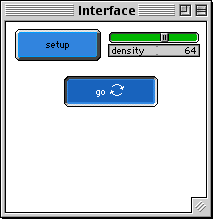
WHAT IS IT? ----------- This project simulates the spread of a fire through a forest. The fire starts on the left edge of the forest, and spreads to neighboring trees. The fire spreads in four directions: north, east, south, and west. The fire's chance of reaching the right edge of the forest depends critically on the density of trees in the forest. HOW TO USE IT ------------- Click the SETUP button to set up the trees (green) and fire (red). Click the GO button to start the simulation. The DENSITY slider controls the density of trees in the forest. (Note: Changes in the DENSITY slider do not take effect until the next SETUP.) THINGS TO NOTICE ---------------- Set the density of trees to 55%. At this setting, there is virtually no chance that the fire will reach the right edge of the forest. Set the density of trees to 65%. At this setting, it is almost certain that the fire will reach the right edge. There is a sharp transition around 59% density. At 59% density, the fire has a 50/50 chance of reaching the right edge. The blue "walls" prevent the fire from spreading off the edges of the screen. EXPLORATIONS ------------ * What if the fire could spread in eight directions (including diagonals)? How would that change the fire's chances of reaching the right edge? In this model, what "critical density" of trees is needed for the fire to propagate? * Add wind to the model so that the fire can "jump" greater distances in certain directions. STARLOGOT FEATURES ----------------- This project uses only patches, no turtles. Each tree uses the StarLogo primitive NSUM4 to determine whether any of the surrounding trees are on fire. Notice how the program gradually decreases the patch color of the red patches to achieve the visual effect of burning. CREDITS and REFERENCES ----------------------- This model was adapted from the fire model the MIT Media Lab. See Resnick, M. (1994) "Turtles, Termites and Traffic Jams: Explorations in Massively Parallel Microworlds." Cambridge, Ma: MIT Press. Adapted to StarLogoT, 1997, as part of the Connected Mathematics Project.